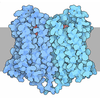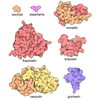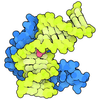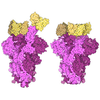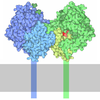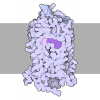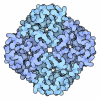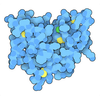+ データを開く
データを開く
- 基本情報
基本情報
| 登録情報 | データベース: PDB / ID: 9v2n | ||||||||||||
|---|---|---|---|---|---|---|---|---|---|---|---|---|---|
| タイトル | Macimorelin bound growth hormone secretagogue receptor in complex with Gq | ||||||||||||
 要素 要素 |
| ||||||||||||
 キーワード キーワード | MEMBRANE PROTEIN/IMMUNE SYSTEM / Macimorelin / growth hormone secretagogue receptor / GHSR / GPCR / MEMBRANE PROTEIN-IMMUNE SYSTEM complex | ||||||||||||
| 機能・相同性 |  機能・相同性情報 機能・相同性情報growth hormone secretagogue receptor activity / regulation of hindgut contraction / regulation of growth hormone secretion / positive regulation of small intestinal transit / negative regulation of locomotion involved in locomotory behavior / growth hormone-releasing hormone receptor activity / regulation of gastric motility / response to follicle-stimulating hormone / regulation of transmission of nerve impulse / ghrelin secretion ...growth hormone secretagogue receptor activity / regulation of hindgut contraction / regulation of growth hormone secretion / positive regulation of small intestinal transit / negative regulation of locomotion involved in locomotory behavior / growth hormone-releasing hormone receptor activity / regulation of gastric motility / response to follicle-stimulating hormone / regulation of transmission of nerve impulse / ghrelin secretion / positive regulation of appetite / growth hormone secretion / negative regulation of norepinephrine secretion / positive regulation of small intestine smooth muscle contraction / negative regulation of macrophage apoptotic process / positive regulation of eating behavior / adult feeding behavior / negative regulation of appetite / actin polymerization or depolymerization / positive regulation of multicellular organism growth / cellular response to thyroid hormone stimulus / response to growth hormone / regulation of postsynapse organization / positive regulation of insulin-like growth factor receptor signaling pathway / response to L-glutamate / positive regulation of vascular endothelial cell proliferation / negative regulation of interleukin-1 beta production / response to food / positive regulation of fatty acid metabolic process / response to dexamethasone / regulation of synapse assembly / cellular response to insulin-like growth factor stimulus / positive regulation of sprouting angiogenesis / regulation of neurotransmitter receptor localization to postsynaptic specialization membrane / decidualization / negative regulation of interleukin-6 production / peptide hormone binding / negative regulation of tumor necrosis factor production / postsynaptic modulation of chemical synaptic transmission / response to hormone / hormone-mediated signaling pathway / insulin-like growth factor receptor signaling pathway / Peptide ligand-binding receptors / synaptic membrane / negative regulation of insulin secretion / electron transport chain / G protein-coupled receptor activity / negative regulation of inflammatory response / Schaffer collateral - CA1 synapse / Olfactory Signaling Pathway / Activation of the phototransduction cascade / G beta:gamma signalling through PLC beta / Presynaptic function of Kainate receptors / Thromboxane signalling through TP receptor / G protein-coupled acetylcholine receptor signaling pathway / G-protein activation / Activation of G protein gated Potassium channels / Inhibition of voltage gated Ca2+ channels via Gbeta/gamma subunits / cellular response to insulin stimulus / Prostacyclin signalling through prostacyclin receptor / G beta:gamma signalling through CDC42 / Glucagon signaling in metabolic regulation / G beta:gamma signalling through BTK / Synthesis, secretion, and inactivation of Glucagon-like Peptide-1 (GLP-1) / ADP signalling through P2Y purinoceptor 12 / photoreceptor disc membrane / Sensory perception of sweet, bitter, and umami (glutamate) taste / Glucagon-type ligand receptors / Adrenaline,noradrenaline inhibits insulin secretion / Vasopressin regulates renal water homeostasis via Aquaporins / Glucagon-like Peptide-1 (GLP1) regulates insulin secretion / G alpha (z) signalling events / cellular response to catecholamine stimulus / ADP signalling through P2Y purinoceptor 1 / ADORA2B mediated anti-inflammatory cytokines production / G beta:gamma signalling through PI3Kgamma / Cooperation of PDCL (PhLP1) and TRiC/CCT in G-protein beta folding / adenylate cyclase-activating dopamine receptor signaling pathway / GPER1 signaling / Inactivation, recovery and regulation of the phototransduction cascade / cellular response to prostaglandin E stimulus / response to estradiol / G-protein beta-subunit binding / heterotrimeric G-protein complex / G alpha (12/13) signalling events / sensory perception of taste / extracellular vesicle / signaling receptor complex adaptor activity / Thrombin signalling through proteinase activated receptors (PARs) / retina development in camera-type eye / cellular response to lipopolysaccharide / GTPase binding / Ca2+ pathway / fibroblast proliferation / High laminar flow shear stress activates signaling by PIEZO1 and PECAM1:CDH5:KDR in endothelial cells / spermatogenesis / G alpha (i) signalling events / G alpha (s) signalling events / phospholipase C-activating G protein-coupled receptor signaling pathway / G alpha (q) signalling events 類似検索 - 分子機能 | ||||||||||||
| 生物種 |  Homo sapiens (ヒト) Homo sapiens (ヒト)   | ||||||||||||
| 手法 | 電子顕微鏡法 / 単粒子再構成法 / クライオ電子顕微鏡法 / 解像度: 2.63 Å | ||||||||||||
 データ登録者 データ登録者 | Wang, R. / Sun, J. / Liu, H. / Guo, S. / Zhang, Y. / Hu, W. / Wang, J. / Liu, H. / Zhuang, Y. / Jiang, Y. ...Wang, R. / Sun, J. / Liu, H. / Guo, S. / Zhang, Y. / Hu, W. / Wang, J. / Liu, H. / Zhuang, Y. / Jiang, Y. / Xie, X. / Xu, H. / Wang, Y. | ||||||||||||
| 資金援助 |  中国, 3件 中国, 3件
| ||||||||||||
 引用 引用 |  ジャーナル: Acta Pharmacol Sin / 年: 2025 ジャーナル: Acta Pharmacol Sin / 年: 2025タイトル: Molecular recognition of two approved drugs Macimorelin and Anamorelin by the growth hormone secretagogue receptor. 著者: Ruo-Lan Wang / Jun Sun / Heng Liu / Shi-Meng Guo / Yu Zhang / Wen Hu / Jiang Wang / Hong Liu / You-Wen Zhuang / Yi Jiang / Xin Xie / H Eric Xu / Yue Wang /  要旨: The growth hormone secretagogue receptor (GHSR) plays a critical role in regulating growth hormone release and metabolic homeostasis. Understanding the molecular mechanisms of ligand-GHSR recognition ...The growth hormone secretagogue receptor (GHSR) plays a critical role in regulating growth hormone release and metabolic homeostasis. Understanding the molecular mechanisms of ligand-GHSR recognition is essential for developing therapeutic interventions. In this study, we investigated the molecular recognition mechanisms of two clinically approved drugs: Macimorelin (used for diagnosing adult growth hormone deficiency) and Anamorelin (approved in Japan for cancer cachexia). Using high-resolution cryo-electron microscopy, we determined the structures of GHSR bound to Macimorelin and Anamorelin in complex with G proteins at resolutions of 2.63 Å and 2.52 Å, respectively. We revealed that both drugs occupied a bifurcated binding pocket divided by a conserved salt bridge between E124 and R283. Through systematic mutagenesis and functional studies, we identified the key residues underlying the higher binding affinity of Anamorelin compared to Macimorelin. In addition, structural comparison of GHSR in complex with different G protein subtypes elucidated the mechanisms driving G protein selectivity. Our results provide crucial insights into GHSR-drug interactions and offer valuable guidance for designing more selective and potent GHSR agonists. | ||||||||||||
| 履歴 |
|
- 構造の表示
構造の表示
| 構造ビューア | 分子:  Molmil Molmil Jmol/JSmol Jmol/JSmol |
|---|
- ダウンロードとリンク
ダウンロードとリンク
- ダウンロード
ダウンロード
| PDBx/mmCIF形式 |  9v2n.cif.gz 9v2n.cif.gz | 303.5 KB | 表示 |  PDBx/mmCIF形式 PDBx/mmCIF形式 |
|---|---|---|---|---|
| PDB形式 |  pdb9v2n.ent.gz pdb9v2n.ent.gz | 表示 |  PDB形式 PDB形式 | |
| PDBx/mmJSON形式 |  9v2n.json.gz 9v2n.json.gz | ツリー表示 |  PDBx/mmJSON形式 PDBx/mmJSON形式 | |
| その他 |  その他のダウンロード その他のダウンロード |
-検証レポート
| 文書・要旨 |  9v2n_validation.pdf.gz 9v2n_validation.pdf.gz | 1.5 MB | 表示 |  wwPDB検証レポート wwPDB検証レポート |
|---|---|---|---|---|
| 文書・詳細版 |  9v2n_full_validation.pdf.gz 9v2n_full_validation.pdf.gz | 1.5 MB | 表示 | |
| XML形式データ |  9v2n_validation.xml.gz 9v2n_validation.xml.gz | 46.6 KB | 表示 | |
| CIF形式データ |  9v2n_validation.cif.gz 9v2n_validation.cif.gz | 71.7 KB | 表示 | |
| アーカイブディレクトリ |  https://data.pdbj.org/pub/pdb/validation_reports/v2/9v2n https://data.pdbj.org/pub/pdb/validation_reports/v2/9v2n ftp://data.pdbj.org/pub/pdb/validation_reports/v2/9v2n ftp://data.pdbj.org/pub/pdb/validation_reports/v2/9v2n | HTTPS FTP |
-関連構造データ
| 関連構造データ |  64734MC  9uy3C M: このデータのモデリングに利用したマップデータ C: 同じ文献を引用 ( |
|---|---|
| 類似構造データ | 類似検索 - 機能・相同性  F&H 検索 F&H 検索 |
- リンク
リンク
- 集合体
集合体
| 登録構造単位 | 
|
|---|---|
| 1 |
|
- 要素
要素
-タンパク質 , 2種, 2分子 AR
| #1: タンパク質 | 分子量: 41855.578 Da / 分子数: 1 / 由来タイプ: 組換発現 / 由来: (組換発現)  Homo sapiens (ヒト) Homo sapiens (ヒト)発現宿主:  |
|---|---|
| #5: タンパク質 | 分子量: 76149.734 Da / 分子数: 1 / 由来タイプ: 組換発現 由来: (組換発現)   Homo sapiens (ヒト) Homo sapiens (ヒト)遺伝子: cybC, GHSR 発現宿主:  参照: UniProt: P0ABE7, UniProt: Q92847 |
-Guanine nucleotide-binding protein ... , 2種, 2分子 BG
| #2: タンパク質 | 分子量: 40226.992 Da / 分子数: 1 / 由来タイプ: 組換発現 / 由来: (組換発現)  Homo sapiens (ヒト) / 遺伝子: GNB1 Homo sapiens (ヒト) / 遺伝子: GNB1発現宿主:  参照: UniProt: P62873 |
|---|---|
| #3: タンパク質 | 分子量: 7861.143 Da / 分子数: 1 / 由来タイプ: 組換発現 / 由来: (組換発現)  Homo sapiens (ヒト) / 遺伝子: GNG2 Homo sapiens (ヒト) / 遺伝子: GNG2発現宿主:  参照: UniProt: P59768 |
-抗体 , 2種, 2分子 NS
| #4: 抗体 | 分子量: 15343.019 Da / 分子数: 1 / 由来タイプ: 組換発現 / 由来: (組換発現)   Escherichia phage EcSzw-2 (ファージ) Escherichia phage EcSzw-2 (ファージ) |
|---|---|
| #6: 抗体 | 分子量: 32561.281 Da / 分子数: 1 / 由来タイプ: 組換発現 / 由来: (組換発現)  発現宿主:  |
-非ポリマー , 1種, 1分子
| #7: 化合物 | ChemComp-A1EQV / 分子量: 474.555 Da / 分子数: 1 / 由来タイプ: 合成 / 式: C26H30N6O3 / タイプ: SUBJECT OF INVESTIGATION |
|---|
-詳細
| 研究の焦点であるリガンドがあるか | Y |
|---|---|
| Has protein modification | N |
-実験情報
-実験
| 実験 | 手法: 電子顕微鏡法 |
|---|---|
| EM実験 | 試料の集合状態: PARTICLE / 3次元再構成法: 単粒子再構成法 |
- 試料調製
試料調製
| 構成要素 | 名称: Macimorelin bound growth hormone secretagogue receptor in complex with Gq タイプ: COMPLEX / Entity ID: #1-#6 / 由来: MULTIPLE SOURCES |
|---|---|
| 由来(天然) | 生物種:  Homo sapiens (ヒト) Homo sapiens (ヒト) |
| 由来(組換発現) | 生物種:  |
| 緩衝液 | pH: 7.3 |
| 試料 | 包埋: NO / シャドウイング: NO / 染色: NO / 凍結: YES |
| 急速凍結 | 凍結剤: ETHANE |
- 電子顕微鏡撮影
電子顕微鏡撮影
| 実験機器 | 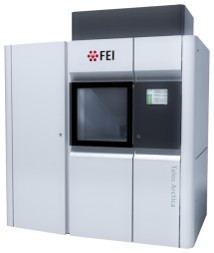 モデル: Talos Arctica / 画像提供: FEI Company |
|---|---|
| 顕微鏡 | モデル: FEI TALOS ARCTICA |
| 電子銃 | 電子線源: OTHER / 加速電圧: 300 kV / 照射モード: OTHER |
| 電子レンズ | モード: OTHER / 最大 デフォーカス(公称値): 2000 nm / 最小 デフォーカス(公称値): 1000 nm |
| 撮影 | 電子線照射量: 50 e/Å2 フィルム・検出器のモデル: FEI FALCON IV (4k x 4k) |
- 解析
解析
| EMソフトウェア | 名称: PHENIX / バージョン: 1.20.1_4487 / カテゴリ: モデル精密化 | ||||||||||||||||||||||||
|---|---|---|---|---|---|---|---|---|---|---|---|---|---|---|---|---|---|---|---|---|---|---|---|---|---|
| CTF補正 | タイプ: PHASE FLIPPING AND AMPLITUDE CORRECTION | ||||||||||||||||||||||||
| 3次元再構成 | 解像度: 2.63 Å / 解像度の算出法: FSC 0.143 CUT-OFF / 粒子像の数: 146801 / 対称性のタイプ: POINT | ||||||||||||||||||||||||
| 精密化 | 最高解像度: 2.63 Å 立体化学のターゲット値: REAL-SPACE (WEIGHTED MAP SUM AT ATOM CENTERS) | ||||||||||||||||||||||||
| 拘束条件 |
|
 ムービー
ムービー コントローラー
コントローラー




 PDBj
PDBj
